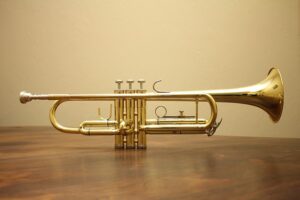 B-flat Trumpet: The Standard
B-flat Trumpet: The Standard
The most common form of trumpet you will encounter today is the B-flat valve trumpet, regarded as the standard in trumpet playing. There was a time when this particular instrument had a switch which could be used to convert it into an A trumpet. However, this didn’t prove popular because it often led to notes being out of tune.
Piccolo Trumpet
Also pitched in B-flat but an octave higher is the piccolo trumpet. Some brass manufacturers also build an A piccolo trumpet which uses a slightly longer leadpipe.
In fact, it is thanks to a piccolo trumpet in A that the instrument came to prominence in pop music. In 1967 English trumpeter David Mason played a piccolo trumpet in A in the trumpet solo of the Beatles’ song ‘Penny Lane’. Paul McCartney had watched a BBC tv broadcast (December 1966) of Bach’s 2nd Brandenburg Concerto by the English Chamber Orchestra in which Mason had played the piccolo trumpet. He loved the sound and asked George Martin to invite the musician into the studio to try out a solo on the song. The rest, as they say, is history! Read more about David Mason and the story of his iconic solo on our trumpet players page.
Other Trumpets
Besides the B-flat instrument, other types of trumpets in use today include:
- The C trumpet – this trumpet is considered by many to be brilliant and flexible but, conversely, regarded as lacking in nobility of tone.
- The D trumpet – this is a small trumpet which particularly helps in the performance of baroque music. This trumpet has been much used by Benjamin Britten (who tends to pitch his third trumpet habitually in D).
- The Trumpet in F – a trumpet actually invented by a composer: Rimsky-Korsakov. Accordigly it is most commonly found in the works of the Russian school of composers, ie. Stravinsky, Shostakovich and Rachmaninov.
- The Bass Trumpet – like the Wagner Tuba, the bass trumpet is an old instrument which still has a place in the modern orchestra. It is pitched in C, B-flat and sometimes E-flat and is usually played by a trombone player because of the similarity of pitch and mouthpiece. One of the first notable uses of the bass trumpet was when Richard Wagner included it in his “Ring Cycle”. Read more about Wagner’s bass trumpet here.
Why Do We Have Different Keyed Trumpets?
Here is an excellent video by Grammy award-winner, the late Jon Ruff in which he explains the difference between the B-flat and C trumpet, explains transposition and why trumpets are in different keys.